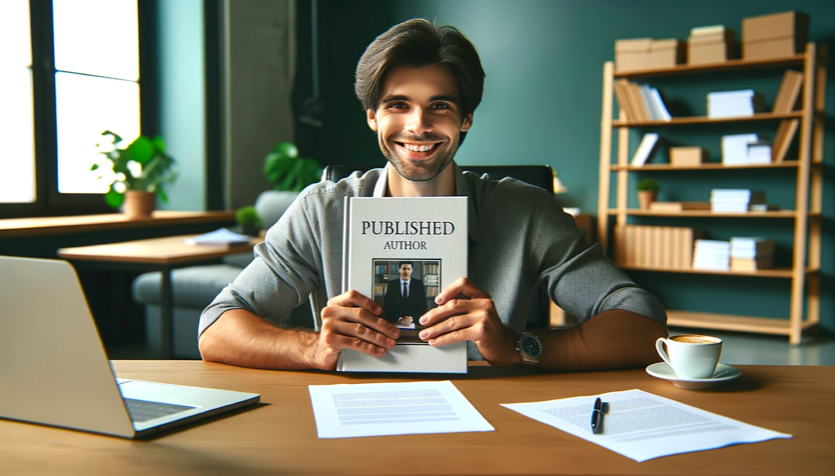Speed and efficiency are crucial in today’s fast-paced digital world, where readers’ attention spans are shorter, and the demand for fresh content is high. As a writer, you may have asked yourself by now, “How long does it take to get a book published?” By mastering the self-publishing timeline and optimizing each step, authors can quickly turn their manuscripts into finished products, reaching their audience faster and staying ahead in the competitive literary market.
Traditional publishing has long been the gold standard for authors, but it comes with significant challenges. The process is notoriously slow, often taking months or even years from manuscript submission to publication. Authors must first secure an agent, which can be a lengthy process involving numerous rejections. Once an agent is secured, the manuscript is submitted to publishing houses, where it undergoes further scrutiny and potential rejection. Even after acceptance, the book goes through extensive editing, design, and marketing phases, adding more time to the process.
In contrast, a self-publishing timeline can offer a faster, more streamlined approach, allowing authors to bring their books to market through fast book publishing in less than 30 days. For those with a self-published book, resources are available to format the book yourself for free, or you can opt to pay for professional formatting services. This accelerated timeline is made possible by cutting out the middlemen and leveraging advanced technology for editing, formatting, and distribution. The idea of publishing a book in such a short period might seem daunting, but with careful planning and efficient workflows, it’s entirely achievable.
Planning Your Book
Having a clear summary of the entire book’s topic is the foundation of a successful book. Before you begin writing the entire book, spend time developing your concept, characters, and plot. A well-defined story idea will guide your writing, helping you maintain focus and coherence throughout the manuscript. This clarity will also make the writing process more enjoyable and less stressful, as you’ll have a roadmap to follow.
Setting a target word count is equally important. Knowing how many words you need to write helps you gauge the scope of your project and break it down into manageable chunks. For instance, if you aim to write a 60,000-word novel, you can divide this into daily or weekly word count goals. This approach makes the task less overwhelming and ensures steady progress.
Creating a production schedule is essential for quick book publishing and keeping on track, especially when aiming to publish in less than 30 days. Start by outlining the major milestones: completing the first draft, revisions, editing, formatting, and finalizing the book cover. Allocate specific timeframes for each stage, considering your daily writing routine and other commitments. A well-structured schedule not only keeps you organized but also provides motivation as you tick off each completed task. By planning meticulously, you can streamline your workflow and move efficiently from idea to published book.
Outlining Your Book
Outlining your book before you start writing offers numerous benefits. It provides a clear roadmap, ensuring your story remains focused and coherent from start to finish. An outline helps you organize your thoughts, identify potential plot holes, and streamline the writing process, reducing the likelihood of writer’s block and making revisions easier.
To structure your outline efficiently, begin with a high-level overview of your story’s key points: the beginning, middle, and end. Break these down into chapters or scenes, noting major plot developments, character arcs, and pivotal moments. This hierarchical approach ensures each part of your story builds logically on the previous one, maintaining a smooth narrative flow.
Several tools and templates can assist with outlining. Software like Scrivener, Microsoft Word, and Google Docs offer customizable templates for outlining. Online tools like Plottr and mind-mapping software can visually organize your ideas. Utilizing these resources can enhance your outlining process, making it more efficient and effective, and setting a solid foundation for your writing journey.
Setting Up a Writing Routine
Establishing a daily writing routine is crucial for achieving your goal of publishing a book in less than 30 days. Incorporating writing sprints that last from 10 minutes to half an hour into your routine can significantly enhance your productivity and word count. A consistent routine helps you develop a habit, making writing a regular part of your day. Set aside a specific time each day dedicated solely to writing, whether it’s early morning, during lunch breaks, or in the evening. The key is to choose a time that fits your schedule and stick to it.
Consistency and discipline are vital in maintaining your writing routine. Treat your writing time as a non-negotiable appointment, just like any other important commitment. By showing up every day, even when you don’t feel inspired, you train yourself to write on demand, ensuring steady progress.
To maximize your writing time, eliminate distractions and create a conducive environment. Turn off notifications, set boundaries with family and friends, and find a quiet space where you can focus. Use techniques like the Pomodoro Technique, which involves writing for 25 minutes, and then taking a 5-minute break, to maintain concentration and prevent burnout. Additionally, setting specific word count goals for each session can keep you motivated and on track. By establishing a disciplined and efficient writing routine, you’ll make significant strides toward completing your manuscript on time.
Your Publishing Journey Awaits – Start NowWriting Sprints
Writing sprints are short, focused bursts of writing, typically lasting 20 to 30 minutes, followed by a brief break. These sprints help increase productivity by encouraging intense concentration and minimizing distractions. By dedicating small, manageable chunks of time to writing, you can make significant progress on your manuscript without feeling overwhelmed.
To set realistic goals for each sprint, start by determining your average writing speed. If you typically write 500 words in 30 minutes, aim for a similar word count during your sprint. Adjust your goals based on your comfort level and the complexity of the section you’re working on.
Staying focused during sprints requires minimizing interruptions and maintaining a conducive environment. Turn off notifications, close unnecessary tabs, and set a timer to keep track of your sprint. Some writers find it helpful to use specific prompts or to plan their writing topics in advance. By staying disciplined and committed during these short, intense writing sessions, you can boost your productivity and quickly move closer to completing your manuscript. This and many other writing exercises can help you achieve your goal and maximize your creative abilities in your writing.
Maximizing Your Writing Time
Finding free time in your day to write can be challenging, but it’s essential for meeting your publishing goal. Identify pockets of time, such as early mornings, lunch breaks, or evenings, where you can dedicate yourself to writing. Even small, consistent intervals can accumulate into substantial progress. In writing fiction, understanding and developing your characters deeply can significantly enhance storytelling, making these focused sessions even more productive.
Using half-hour writing sessions effectively involves clear focus and preparation. Before each session, know exactly what you plan to write. This preparation allows you to dive straight into writing without wasting time. Set specific, achievable goals for each session, such as completing a scene or reaching a word count.
Minimizing distractions is crucial for maintaining productivity. Create a dedicated writing space free from interruptions. Turn off notifications on your devices, inform family or roommates of your writing time, and consider using productivity tools like website blockers. By optimizing these short, focused sessions, you can significantly enhance your writing output and stay on track with your publishing timeline.
The First Draft
Getting the first draft down quickly is crucial for several reasons. It allows you to capture your ideas while they’re fresh and keeps the creative momentum going. Speed is especially important when aiming to publish in less than 30 days, as it leaves more time for revisions and editing. A fast first draft also helps you stay motivated, as seeing tangible progress can boost your confidence and commitment.
Overcoming the blank page can be daunting, but there are effective techniques to help. Start with a clear outline, so you know exactly what to write next. Freewriting, where you write continuously without worrying about grammar or coherence, can help get your thoughts flowing. If you’re stuck, skip to a different part of your story that excites you and come back later to fill in the gaps.
Maintaining momentum is key to completing your first draft swiftly. Set daily word count goals that are challenging yet achievable. Writing in short, focused bursts, like using the Pomodoro Technique, can help maintain energy and focus. Celebrate small victories to stay motivated, and if you encounter writer’s block, take short breaks to recharge. By prioritizing speed and maintaining a steady pace, you can quickly transform your ideas into a complete first draft, setting the stage for a polished final product.
Revising and Editing
Revising and editing are crucial stages in transforming your first draft into a polished, publishable book. The importance of subsequent drafts cannot be overstated; they allow you to refine your story, fix inconsistencies, and enhance overall readability. Each new draft is an opportunity to improve your work, ensuring it meets your vision and resonates with readers.
During the revision process, start by reviewing your manuscript for major structural issues. Look at the overall flow of the story, character development, and plot coherence. Address any gaps or inconsistencies and ensure each scene contributes to the narrative. Next, focus on refining your prose—tighten sentences, improve dialogue, and eliminate unnecessary words. Pay attention to pacing and ensure each chapter ends with a hook to keep readers engaged.
Utilizing a word processor’s tools can significantly enhance the editing process. Most word processors offer features like spell check, grammar check, and style suggestions. Use track changes to keep a record of your edits, making it easier to review and adjust as needed. Comment features allow you to leave notes for yourself or your editor. Additionally, readability statistics can help you gauge the complexity of your text, ensuring it aligns with your target audience. By methodically revising and leveraging these tools, you can produce a well-crafted, professional manuscript ready for publication.
Seeking Feedback
Finding an accountability partner or writing partner can be invaluable in your writing journey. This person can provide support, motivation, and a second pair of eyes on your work. Regular check-ins and mutual encouragement help maintain progress and keep you on track.
Feedback from other writers is crucial for improving your manuscript. Fellow writers can offer insights into plot development, character consistency, and pacing. They can spot issues you might have overlooked and suggest creative solutions. Joining a writing group or participating in online writing communities are great ways to connect with other writers for feedback.
Incorporating constructive criticism involves being open and objective. Carefully review the feedback, looking for common themes or repeated suggestions. Prioritize changes that enhance clarity, coherence, and overall quality. Remember, the goal is to improve your manuscript, not to defend it. By embracing constructive criticism, you can refine your work and ensure it resonates well with readers.
Professional Editing
Hiring a professional editor is crucial for transforming your manuscript into a polished, publishable book. A professional editor brings an objective perspective and expertise that can significantly enhance the quality of your work. They help identify and correct issues you may have missed, ensuring your book is clear, engaging, and error-free.
There are different types of editing, each serving a specific purpose:
- Developmental Editing: This is the first stage of editing, focusing on the overall structure and content of your manuscript. Developmental editors help refine the plot, character development, pacing, and narrative flow. They provide feedback on major elements and suggest significant revisions to improve the story.
- Copyediting: After the developmental stage, a copyeditor works on the finer details. They address grammar, punctuation, syntax, and style consistency. Copyediting ensures that your manuscript adheres to language standards and maintains a consistent tone and voice.
- Proofreading: The final stage of editing is proofreading, which involves a meticulous review of the manuscript to catch any remaining typos, formatting issues, or minor errors. Proofreaders ensure that the book is ready for publication and free of distractions for readers.
To find a good editor, start by seeking recommendations from fellow authors or writing communities. Look for editors with experience in your genre and check their credentials, testimonials, and portfolio. Many editors offer sample edits or consultations, which can help you gauge their compatibility with your project. Investing in a professional editor is essential for producing a high-quality book that meets the standards of your readers and the publishing industry.
Book Cover Design
A professional book cover is crucial as it serves as the first impression of your book and can significantly influence potential readers’ decisions. A well-designed cover captures attention, conveys the genre and tone, and reflects the quality of the content inside. Investing in a professional cover can greatly enhance your book’s marketability and appeal.
If you choose to design your own cover, focus on clarity, relevance, and visual appeal. Use high-quality images and readable fonts, ensuring the title and author name are prominent. Study successful covers in your genre for inspiration and adhere to design principles that attract your target audience.
Alternatively, hiring a professional designer can ensure a polished and effective cover. Look for designers with experience in book cover design, review their portfolios, and check testimonials from previous clients. Many freelance platforms, such as Upwork and Fiverr, offer access to skilled designers.
There are also numerous tools and resources for cover design. Software like Adobe Photoshop and Canva provides customizable templates and design elements. Websites like BookBrush and DIY Book Covers offer user-friendly platforms for creating professional covers without extensive design skills. Utilizing these resources can help you produce a compelling cover that enhances your book’s success.
Formatting Your Book
Proper formatting is essential for ensuring your book looks professional across different platforms. Each self-publishing platform, such as Amazon Kindle Direct Publishing or IngramSpark, has specific formatting guidelines. Adhering to these guidelines ensures your book is compatible with various devices and print specifications, providing readers with a seamless experience.
Several tools can help with formatting eBooks and print books. For eBooks, software like Calibre, Scrivener, and Vellum offers user-friendly options for converting your manuscript into formats like EPUB and MOBI. For print books, Adobe InDesign and Microsoft Word provide robust tools for setting margins, fonts, and page layouts to meet industry standards.
The importance of a polished final product cannot be overstated. A well-formatted book enhances readability, making it easier for readers to engage with your content. It also reflects your professionalism and attention to detail, which can positively impact reviews and sales. Investing time in proper formatting ensures your book stands out in a competitive market and provides a high-quality reading experience.
Your Publishing Journey Awaits – Start NowSelf-Publishing Platforms
Choosing the right self-publishing platform is a crucial step in bringing your book to market. Popular platforms include Amazon Kindle Direct Publishing (KDP), IngramSpark, Smashwords, and Spines, each offering unique features and benefits.
Spines
Spines combines advanced AI technology with human expertise to offer a comprehensive and efficient self-publishing timeline. The streamlined process ensures that you can transition from manuscript to published book in less than 30 days. Comprehensive plans are budget-friendly and significantly lower than industry standards, thanks to our AI-driven cost efficiency in production. The supportive guidance of your personal production manager will be there for you at every step. Whether it’s POD (Print-on-Demand), eBooks, or audiobooks, Spines provides all the formats you need to reach your audience and distribute globally. Whether you’re taking your first steps in writing or are an established author, Spines is tailored for your success in publishing.
Amazon Kindle Direct Publishing (KDP)
KDP is a popular self-publishing platform, offering extensive reach through Amazon’s marketplace. It provides tools for both eBook and print-on-demand publishing. Pros include a large potential audience, ease of use, and competitive royalties. However, the cons include strict formatting requirements and exclusivity options that can limit distribution if you opt for KDP Select.
IngramSpark
IngramSpark offers extensive distribution options, including access to bookstores, libraries, and online retailers. It supports both print and eBooks. Pros include high-quality print options and wide distribution. The cons are upfront costs and a more complex setup process compared to KDP.
Smashwords
Smashwords focuses primarily on eBook distribution, providing access to various online retailers and libraries. Pros include broad distribution and marketing tools. However, the cons include a more complicated formatting process and limited print options.
Choosing the Right Platform for Fast Book Publishing
To choose the right platform, consider your goals and priorities. If maximum reach and ease of use are paramount, KDP might be the best choice. For wider distribution in physical stores and libraries, IngramSpark is ideal. If you’re focused on eBooks with broad digital distribution, Smashwords could be the way to go. For a comprehensive, AI-enhanced publishing experience that includes all formats and global distribution, Spines stands out as an excellent option. Evaluate the pros and cons of each platform in the context of your specific needs to make an informed decision.
Setting Your Publication Date
Choosing a realistic publication date is essential for a successful book launch. Consider the time needed for writing, revising, editing, formatting, and cover design. Factor in potential delays and give yourself ample time to complete each stage without rushing. Typically, setting a date at least a month or two after finishing the final draft allows for a thorough preparation process.
Sticking to your schedule is crucial to maintain momentum and ensure a timely release. Create a detailed timeline with specific deadlines for each task, such as editing completion, formatting finalization, and cover approval. Use productivity tools and set reminders to keep on track.
To prepare for your launch, start by finalizing your manuscript and cover design. Set up your book on your chosen self-publishing platform, ensuring all details are correctly entered. Plan and execute a marketing strategy, including social media promotion, email newsletters, and potential collaborations with influencers or bloggers. By adhering to your schedule and preparing meticulously, you can achieve a smooth and successful book launch.
Marketing Your Book
A well-crafted marketing plan is crucial for the success of your book. Without effective marketing, even the best-written books can go unnoticed. A marketing plan helps you define your target audience, set goals, and outline the strategies you’ll use to reach potential readers.
Strategies for Promoting Your Book Pre-Launch:
1. Build Anticipation: Start by creating buzz around your book well before the release date. Share sneak peeks, cover reveals, and updates on your writing progress to engage your audience.
2. Advance Reviews: Send advance review copies (ARCs) to bloggers, influencers, and reviewers. Positive reviews and endorsements can significantly boost your book’s credibility and visibility.
3. Email Marketing: Build an email list and keep your subscribers informed about the launch. Offer exclusive content, such as sample chapters or behind-the-scenes insights, to generate excitement.
Strategies for Promoting Your Book Post-Launch:
1. Launch Events: Host virtual or in-person launch events. Live readings, Q&A sessions, and book signings can attract attention and drive sales.
2. Book Giveaways: Organize giveaways on platforms like Goodreads or your social media channels to increase visibility and attract potential readers.
3. Continued Engagement: Keep engaging with your audience post-launch. Share updates, respond to reviews, and continue promoting your book through various channels.
Utilizing Social Media and Other Platforms:
Social media platforms like Facebook, Twitter, Instagram, and TikTok are powerful tools for book marketing. Create a content calendar and post regularly to maintain a consistent presence. Use hashtags relevant to your genre and engage with reader communities. Additionally, consider utilizing book promotion sites, podcasts, and author collaborations to broaden your reach. By leveraging these platforms effectively, you can maximize your book’s exposure and connect with a wider audience.
Building an Author Platform
An author platform is your presence and influence as a writer, both online and offline. It includes your website, social media profiles, email list, and any other avenues through which you connect with readers and promote your work. Having a strong author platform is essential because it helps you build a loyal audience, establish credibility, and increase your book sales.
Steps to Build and Grow Your Platform:
1. Create a Professional Website: Your website is your digital home. Include an engaging bio, information about your books, a blog, and contact details. Ensure it’s easy to navigate and visually appealing.
2. Establish a Social Media Presence: Choose the platforms where your target audience is most active. Consistently post engaging content, share updates about your writing journey, and interact with your followers.
3. Start an Email List: Offer a freebie, such as a short story or a sample chapter, to encourage sign-ups. Regularly send newsletters with updates, exclusive content, and book promotions.
4. Guest Blogging and Podcasts: Write guest posts for popular blogs in your genre and appear on podcasts to reach new audiences and build your credibility.
Engaging with Your Audience:
Engagement is key to growing your platform. Respond to comments and messages, and show genuine interest in your readers. Host Q&A sessions, live readings, and giveaways to foster a sense of community. Share behind-the-scenes glimpses into your writing process and celebrate milestones with your audience. By maintaining consistent and meaningful interactions, you can build a strong connection with your readers, ensuring they remain invested in your work and eagerly anticipate your future projects.
Handling Book Sales and Royalties
Understanding royalty structures on different self-publishing platforms is crucial for maximizing your earnings. Platforms like Amazon Kindle Direct Publishing (KDP) offer royalty rates of 35% or 70% depending on your book’s pricing and distribution choices. IngramSpark provides varied rates based on distribution channels, while platforms like Smashwords offer different splits based on sales channels.
Tracking your book sales is essential for gauging your success and making informed decisions. Most platforms provide detailed sales dashboards where you can monitor daily, weekly, and monthly sales. Utilize spreadsheets or dedicated accounting software to keep track of your earnings and expenses. Regularly reviewing this data helps you understand trends and plan your marketing strategies accordingly.
To maximize your earnings as a self-published author, consider pricing strategies that balance competitiveness and profitability. Take advantage of promotional opportunities, such as discounted periods or free book giveaways, to boost visibility and sales. Diversify your income streams by offering print, eBook, and audiobook versions of your book. By understanding royalty structures, diligently tracking sales, and strategically pricing and promoting your book, you can enhance your financial success as a self-published author.
Your Publishing Journey Awaits – Start NowDealing with Traditional Publishers
Self-publishing and traditional publishing differ significantly in terms of control, speed, and resources. Self-publishing offers complete creative control and a faster route to market but requires authors to handle all aspects of production and marketing. Traditional publishing, on the other hand, provides professional editing, design, and marketing support but often involves lengthy submission processes and less control over the final product.
If you choose to approach traditional publishers, start by researching publishers and agents who specialize in your genre. Look for submission guidelines on their websites and ensure your manuscript fits their requirements.
Writing a query letter is crucial in this process. A strong query letter should include a compelling summary of your book, a brief author bio, and any relevant writing credentials. Personalize each letter to the specific agent or publisher, explaining why your book would be a good fit for them. By carefully researching and crafting your submission materials, you increase your chances of catching the attention of traditional publishers and agents.
Continuous Improvement
Learning from each publishing experience is vital for long-term success as an author. Every book you publish offers valuable insights into your writing process, marketing strategies, and audience preferences. Analyzing what worked well and what didn’t helps you refine your approach for future projects.
To improve your writing and publishing process for your next novel, start by seeking feedback from readers and other writers. Identify areas where you can enhance your storytelling skills, pacing, and character development. Experiment with different writing techniques and tools to find what best suits your style and workflow.
Engage with resources for ongoing education and support. Join writing groups and forums, attend workshops and webinars, and read books on writing craft and publishing. Websites like Writer’s Digest, Reedsy, and NaNoWriMo offer excellent resources and community support. By continuously learning and adapting, you can elevate the quality of your work and achieve greater success with each new book.
Common Pitfalls to Avoid
Many writers encounter common pitfalls during the publishing process, such as neglecting thorough editing, rushing the publication, and insufficient marketing efforts. These mistakes can compromise the quality of your book and hinder its success.
To avoid these issues, prioritize a meticulous editing process, including professional proofreading and multiple revision rounds. Resist the urge to rush; instead, follow a well-structured production schedule. Additionally, invest time and resources into a robust marketing plan to build anticipation and reach a broader audience.
If you encounter setbacks, such as negative reviews or slow sales, use them as learning opportunities. Analyze feedback objectively to identify areas for improvement. Revise your marketing strategies and consider re-launching with new promotional efforts. Persistence and adaptability are key—by learning from mistakes and continually refining your approach, you can overcome obstacles and achieve your publishing goals.
Real-Life Success Stories
Self-published authors who found success can be a great source of inspiration and learning for new writers. One notable example is Andy Weir, author of “The Martian.” Weir initially self-published his novel on his blog, and due to its popularity, it was picked up by a traditional publisher and later turned into a successful movie. Weir’s story highlights the importance of engaging with readers and using feedback to refine your work.
Another example is Amanda Hocking, who became a self-publishing sensation with her paranormal romance series. After facing numerous rejections from traditional publishers, Hocking self-published her books and sold over a million copies. Her success underscores the power of perseverance and understanding market trends.
Hugh Howey, author of the “Wool” series, also found immense success through self-publishing. Howey retained his eBook rights while negotiating print-only deals with traditional publishers, showcasing the potential for hybrid publishing models.
Lessons from these authors include the importance of building a loyal readership, leveraging digital platforms for marketing, and being open to different publishing opportunities. For new writers, these success stories offer encouragement and proof that with dedication, strategic planning, and a willingness to adapt, self-publishing can lead to remarkable achievements and broad recognition.
Fast-Track Finale: Your 30-Day Roadmap to Becoming a Published Author
In this article, we’ve explored the key steps to publishing your book in less than 30 days, focusing on speed and efficiency. We began by addressing the challenges of traditional publishing and highlighted the benefits of a self-publishing timeline. From planning and outlining your book to setting up a consistent writing routine, each stage was detailed to help you stay on track. We discussed the importance of quick first drafts, effective revising and editing, and seeking professional feedback. Essential elements like book cover design, formatting, and choosing the right self-publishing platform were covered to ensure a polished final product. We also delved into marketing strategies, building an author platform, and handling book sales and royalties, while emphasizing continuous improvement and learning from real-life success stories.
Starting your publishing journey can be daunting, but with the right approach, it’s entirely achievable. Embrace the process, stay disciplined, and don’t be afraid to seek help and feedback along the way.
Final tips for success include maintaining a positive mindset, staying organized with a clear schedule, and continually engaging with your audience. Remember, every step taken brings you closer to your goal of becoming a published author. With dedication, strategic planning, and a willingness to learn and adapt, you can successfully publish your book in less than 30 days and share your unique voice with the world.
Your Publishing Journey Awaits – Start NowFAQs – How Long Does it Take to Get a Book Published
Q: How quickly can a book be published?
With modern-day quick book publishing, you can publish a book in as little as a few weeks, depending on editing, formatting, and distribution choices. Self-publishing timelines are the fastest, while traditional publishing can take months or even years.
Q: How difficult is it to get a book published?
Fast book publishing services make publishing easier than ever, especially with self-publishing options that eliminate gatekeepers. Traditional publishing is more competitive and requires agent and publisher approval, while self-publishing gives you full control.
Q: How quickly can I get a book printed?
Using fast book publishing services, print-on-demand (POD) allows books to be printed within days. If you choose bulk printing, it may take a few weeks depending on the quantity and provider.
Q: How long does it take to get a book published or accepted?
With traditional publishing, acceptance can take months to years due to querying, agent negotiations, and review cycles. However, there are options for quick book publishing through self-publishing timelines, which skip this process, allowing you to publish immediately.
Q: What is the best time of year to publish a book?
The advanced technology of fast book publishing allows you to release books anytime, but major seasons like fall (for holiday sales) and spring (for fresh releases) are ideal. For niche books, timing around industry events or trends can maximize impact.
Q: What is the easiest type of book to get published?
For quick book publishing, short-form books like e-books, guides, and children’s books are the easiest due to minimal formatting and quicker production. Genres like self-help and romance also have high self-publishing success rates.
Q: Will I make more money with a self-publisher or a traditional publisher?
Fast book publishing through self-publishing often provides higher royalties (up to 70% on platforms like Amazon KDP), whereas traditional publishers offer lower royalties (5-15%) but provide advance payments and marketing support. Your earnings depend on marketing and audience reach.







